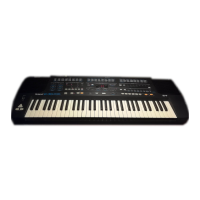
Do you have a question about the Roland E-36 and is the answer not in the manual?
| Type | Arranger Keyboard |
|---|---|
| Number of Keys | 61 |
| Sound Engine | PCM |
| Drum Sets | 8 |
| Display | LCD |
| Tones | 128 |
| Rhythms | 64 |
| Effects | Reverb, Chorus |
| MIDI | In, Out |
| Connections | Headphones, MIDI |
| Power Supply | AC Adaptor |
| Styles | 64 styles |
Warnings regarding battery usage and potential hazards.
Identifies where to find the instrument's model and serial number.
Lists the items included in the instrument's package.
Details the main features and functionalities of the E-36 synthesizer.
Precautions for safe electrical connections and power adapter usage.
Specifications for keyboard, sound generation, and polyphony.
Details on musical styles, effects, and the instrument's display.
Information on power supply, connections, dimensions, and amplification.
Guidance on suitable placement and environmental conditions for the instrument.
Instructions for connecting the power adapter and verifying voltage.
Explains the operation of power, display, and demo song playback.
Details on connecting headphones, MIDI devices, and accessories like style cards.
Information on selecting music styles and tone groups.
Explains controls for volume, modulation, and pitch shift.
Details on tone section controls and accompaniment volume adjustment.
Functions related to chord intelligence and memory storage.
How to use style variation and intro/ending functions.
Using tempo buttons and the tap tempo feature for style adjustment.
Controls for selecting tones, tuning, and transposing.
How to activate and control chorus and reverb effects.
Instructions for playing the built-in demo songs.
Guidance on selecting different music styles.
Steps to select and apply tone variations.
How to choose between Tone Groups A and B.
Selecting arranger modes and inserting fill-ins.
Using style variation and intro/ending functions.
How to use the instrument's built-in recorder.
Selecting MIDI parts and data for MIDI communication.
Initial steps to begin playing the instrument.
Guidance on how to play the demonstration songs.
Step-by-step guide to selecting tones for the upper keyboard section.
How to select tone groups and specific tone numbers.
Explains different keyboard modes like Chord, Split, and Arranger.
How to set and adjust the keyboard's split point.
Process for selecting tones and managing banks.
How to select and apply tone variations in the upper section.
Methods for selecting tones for the lower keyboard section.
Detailed steps for setting the split point between keyboard sections.
How to choose and play from the available drum sets.
Guide to selecting and playing accompaniment styles.
Instructions for inserting and using music style cards.
How to adjust the tempo of selected music styles.
Using the tap tempo feature to set the style's tempo.
How to play introductions and endings for music styles.
How to insert fill-in beats into music styles.
Managing the arranger section and storing chords.
How to play simplified chords using chord intelligence.
Using the melody intelligence feature.
Adjusting the volume of accompaniment and melody sections separately.
How to synchronize the arranger with the instrument.
Changing the instrument's pitch using transpose.
How to tune the instrument's pitch.
Steps to record songs using the instrument's recorder.
How to listen to recorded songs.
Overview of the General MIDI System.
Explanation of the Roland GS Format.
How to connect the instrument to other MIDI devices.
How to select and adjust various MIDI parameters.
How to enable or disable GM mode functions.
List of MIDI parameters available in normal (GM Off) mode.
List of MIDI parameters available in GM (On) mode.
Procedure to load original MIDI parameters.
Guide to operating the instrument in GM mode.
Adjusting volumes for GM melody and harmony sections.
Adjusting volumes for GM accompaniment and drums sections.
Instructions for cleaning the synthesizer.
Checklist for diagnosing and resolving instrument issues.
Comprehensive lists of available instrument tones.
Comprehensive lists of available drum sets.
How to play major chords using intelligent chord functions.
Details on basic MIDI functions like channel, mode, and velocity.
Information on control change and program change messages.